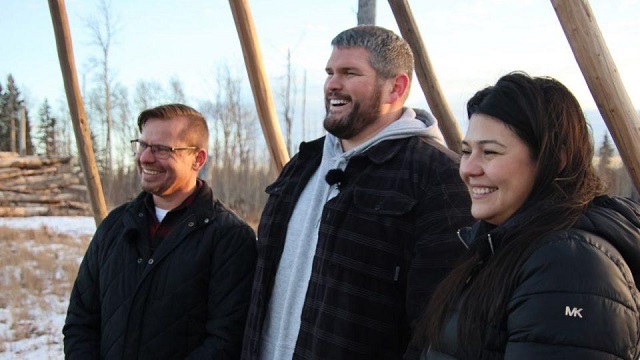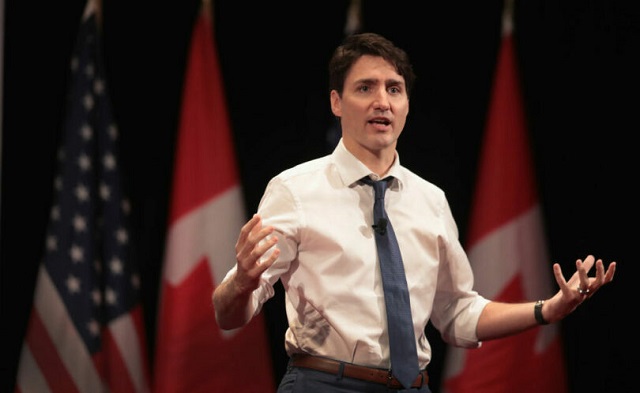Canadian Energy Centre
Why Canada’s proposed oil and gas emissions cap goes against UNDRIP and the rights of Indigenous people

Indigenous Resource Network executive director John Desjarlais (centre), with Justin Bourque, president of Âsokan Generational Developments, and Shelby Kennedy, community and Indigenous relations advisor with Enbridge. Photo courtesy Indigenous Resource Network
From the Canadian Energy Centre
Q&A with John Desjarlais, executive director of the Indigenous Resource Network
The Indigenous Resource Network (IRN) is pushing back on Canada’s proposed framework to cap emissions from the oil and gas sector.
IRN executive director John Desjarlais says the proposal directly contradicts Canada’s support for the United Nations Declaration on the Rights of Indigenous People (UNDRIP).
He says the plan would cap opportunity for Indigenous communities as more take on ownership positions in major energy projects from oil and gas pipelines to liquefied natural gas terminals and carbon capture and storage projects.
Here’s what Desjarlais told CEC.
CEC: From the perspective of Indigenous communities across Canada who are involved in natural resources development, what’s your take on the federal government’s proposed oil and gas emissions cap?
John Desjarlais: There’s a lot of confidence that it will curtail production as well, and obvious concern that it’s going to mean less opportunity.
We’ve heard from communities that are saying we’re involved already in emissions reduction. There are communities that just want to advance their opportunities in that space. And it’s at a time when there’s probably the greatest appetite for Indigenous involvement, not just in ownership, but advanced business development and procurement. [It could] mean less jobs, less procurement, less ownership opportunity, less investment.
There are concerns that these impacts are not being heavily understood, measured, contemplated or considered in terms of the policy development and implementation.
CEC: How does being involved in oil and gas development benefit Indigenous communities?
JD: There’s a suite of benefits that are coming from increased engagement, and it’s much deeper than just jobs.
Communities are now jumping into revenue generating assets where they’re creating immediate cash flow, which is allowing them to start to self-determine and invest back into their community either through economic development or through infrastructure programming.
The other side to it is just the capacity that comes from being involved as an owner. Indigenous business and community leaders are being exposed to the requirements and the acumen needed to successfully participate in the ownership of decision making. That’s accelerating the development of the acumen and capacity of different indigenous communities at greater rates
CEC: How many communities would you estimate are now participating at this level?
JD: There’s probably upwards directly of at least 100 different communities now. There are double-digit communities that are involved in at least four or five different deals that are directly involved in the ownership and the benefit side, and then there’s cascading involvement of all the surrounding communities through procurement opportunities and employment. It’s growing quite quickly.
CEC: Why do you say the proposed emissions cap contradicts the United Nations Declaration on the Rights of Indigenous People?
It’s a policy that’s created to achieve certain goals. Creating those types of targets without Indigenous oversight – not just input, [but] oversight and ownership – is problematic because it contradicts the UNDRIP action plan in terms of stepping out of the way of affording Indigenous peoples and communities the ability to self-determine; to invest where they want to invest, and to grow how they want to grow.
We hear a lot of community leaders say, ‘we know what’s best for our territories.’ To have policy that limits our ability to make the decisions we want to make in regard to environmental and economic sustainability is a challenge.
CEC: What would you like to see happen?
JD: It’s a little hard to roll back and involve communities in a total redesign, but at least if we saw an understanding that there’s certainly going to be an economic impact. If there’s a production cap aspect to it, there’s going to be an economic impact to those Indigenous communities that have established livelihoods and revenue streams.
There’s the sentiment that if the government truly is advancing this in the direction that they are, then would they consider omission of Indigenous activity so they can continue advancing their economic interests and growth?
Ideally, [there would be] a policy that’s created in line with UNDRIP that works for communities, industries and governments in their goals.
Alberta
Canada’s advantage as the world’s demand for plastic continues to grow

From the Canadian Energy Centre
By Will Gibson
‘The demand for plastics reflects how essential they are in our lives’
From the clothes on your back to the containers for household products to the pipes and insulation in your home, plastics are interwoven into the fabric of day-to-day life for most Canadians.
And that reliance is projected to grow both in Canada and around the world in the next three decades
The Global Plastics Outlook, published by the Paris-based Organization for Economic Co-operation and Development (OECD), forecasts the use of plastics globally will nearly triple by 2060, driven by economic and population growth.
The use of plastics is projected to double in OECD countries like Canada, the United States and European nations, but the largest increases will take place in Asia and Africa.
“The demand for plastics reflects how essential they are in our lives, whether it is packaging, textiles, building materials or medical equipment,” says Christa Seaman, vice-president, plastics with the Chemical Industry Association of Canada (CIAC), which represents Canada’s plastics producers.
She says as countries look to meet climate and sustainability goals, demand for plastic will grow.
“Plastics in the market today demonstrate their value to our society. Plastics are used to make critical components for solar panels and wind turbines. But they also can play a role in reducing weight in transportation or in ensuring goods that are transported have less weight in their packaging or in their products.”
Canada produces about $35 billion worth of plastic resin and plastic products per year, or over five per cent of Canadian manufacturing sales, according to a 2019 report published by the federal government.
Seaman says Canadian plastic producers have competitive advantages that position them to grow as demand rises at home and abroad. In Alberta, a key opportunity is the abundant supply of natural gas used to make plastic resin.
“As industry and consumer expectations shift for production to reduce emissions, Canada, and particularly Alberta, are extremely well placed to meet increased demand thanks to its supply of low-carbon feedstock. Going forward, production with less emissions is going to be important for companies,” Seaman says.
“You can see that with Dow Chemical’s decision to spend $8.8 billion on a net zero facility in Alberta.”
While modern life would not be possible without plastics, the CIAC says there needs to be better post-use management of plastic products including advanced recycling, or a so-called “circular economy” where plastics are seen as a resource or feedstock for new products, not a waste.
Some companies have already started making significant investments to generate recyclable plastics.
For example, Inter Pipeline Ltd.’s $4.3 billion Heartland Petrochemical Complex near Edmonton started operating in 2023. It produces a recyclable plastic called polypropylene from propane, with 65 per cent lower emissions than the global average thanks to the facility’s integrated design.
Achieving a circular economy – where 90 per cent of post-consumer plastic waste is diverted or recycled – would benefit Canada’s economy, according to the CIAC.
A Deloitte study, commissioned by Environment & Climate Change Canada, estimated diverting or reusing 90 per cent of post-consumer plastic waste by 2030 will save $500 million annually while creating 42,000 direct and indirect jobs. It would also cut Canada’s annual CO2 emissions by 1.8 megatonnes.
Right now, about 85 per cent of plastics end up in Canada’s landfills. To reach the 90 per cent diversion rate, Seaman says Canada must improve its infrastructure to collect and process the plastic waste currently being landfilled.
But she also says the industry rather than municipalities need to take responsibility for recycling plastic waste.
“This concept is referred to as extended producer responsibility. Municipalities have the responsibility for managing recycling within a waste management system. Given the competing costs and priorities, they don’t have the incentive to invest into recycling infrastructure when landfill space was the most cost-effective solution for them,” she says.
“Putting that responsibility on the producers who put the products on the market makes the most sense…The industry is adapting, and we hope government policy will recognize this opportunity for Canada to meet our climate goals while growing our economy.”
Business
Decarbonization deal opens new chapter in Alberta-Japan relationship

From the Canadian Energy Centre
By Will Gibson
Agreement represents a homecoming for JAPEX, which first started work in the Alberta oil sands in 1978
A new agreement that will see Japan Petroleum Exploration Company (JAPEX) invest in decarbonization opportunities in Alberta made history while also being rooted in the past, in the eyes of Gary Mar.
JAPEX is seeking to develop projects in carbon capture and storage (CCS), hydrogen and bioenergy. It’s part of the company’s JAPEX2050 strategy toward carbon neutrality.
“This new endeavour is a great opportunity that demonstrates the world is changing but the relationships endure,” says Mar, the province’s former trade envoy to Asia and the current CEO of the Canada West Foundation.
“Alberta’s very first international office was opened in Tokyo in 1981. And we have built a tremendous soft infrastructure that includes partnerships between a dozen Alberta and Japanese universities.”
For JAPEX, the agreement represents something of a homecoming for the company that first started work in the Alberta oil sands in 1978 and operated one of the first in situ (or drilled) oil projects for nearly two decades before selling its stake in 2018.
“We are now aiming to come back to Alberta and contribute to its decarbonization,” JAPEX president of overseas business Tomomi Yamada said in a statement.
Mar says the memorandum of understanding signed this March between JAPEX and the crown corporation Invest Alberta stems from a strong relationship built over decades.
“You can’t be considered a reliable partner for a new venture if you haven’t been a reliable partner for decades in the past,” says Mar.
“Economies change and world’s needs change but strong relationships are important factor in whom you do business with.”
Alberta’s established CCS infrastructure has already attracted new investment, including Air Products’ $1.6-billion net zero hydrogen complex and Dow Chemicals’ $8.8-billion net zero petrochemical complex.
Mar sees JAPEX’s deal with Invest Alberta opening a whole new market of potential carbon neutral investors in the Pacific Rim.
“When other countries who are partners in the Trans-Pacific Partnership (TPP) see JAPEX invest in this decarbonization opportunities and net zero projects in Alberta, it will send a very clear signal to others in the TPP about the potential,” Mar says.
“This deal may come from the decades-long relationship between Alberta and Japan but can also serve as a signpost for decades to come.”
-

 Censorship Industrial Complex2 days ago
Censorship Industrial Complex2 days agoNow We Are Supposed to Cheer Government Surveillance?
-

 Alberta2 days ago
Alberta2 days agoRed Deer Doctor critical of Alberta’s COVID response to submit report to Danielle Smith this May
-

 Business1 day ago
Business1 day agoUN plastics plans are unscientific and unrealistic
-

 Business23 hours ago
Business23 hours agoTaxpayers criticize Trudeau and Ford for Honda deal
-

 Alberta2 days ago
Alberta2 days agoAlberta’s baby name superstar steals the show again
-

 Uncategorized2 days ago
Uncategorized2 days agoThe end of Canada: The shift from democracy to totalitarian behavior in the ‘pandemic era’
-

 Business1 day ago
Business1 day agoDon’t be fooled by high-speed rail
-

 Alberta1 day ago
Alberta1 day agoActivity-Based Hospital Funding in Alberta: Insights from Quebec and Australia







